 People visit Dadar Chowpatty amid hazy weather conditions. (PTI)
People visit Dadar Chowpatty amid hazy weather conditions. (PTI)The air quality of Mumbai dropped to the ‘poor’ category yet again, after staying in the ‘moderate’ range for the past two weeks.
According to the Air Quality Index (AQI) readings obtained from the System of Air Quality Forecast and Research (SAFAR), Mumbai’s AQI read 215 Wednesday afternoon, which is labelled as ‘poor’.
Even on November 6 (Sunday), Mumbai’s AQI reading was a ‘moderate’ 128.
According to the AQI monitoring chart, an AQI reading between 0-50 is termed ‘good’, between 51-100 is considered ‘satisfactory’, 101-200 is regarded as ‘moderate’, 201-300 is termed ‘poor’, 301-400 is classified as ‘very poor’ and beyond 400 is labelled as ‘severe’.
Data also showed that the primary constituents were PM2.5 components, which are air particulate matters that have a diameter of less than 2.5 micrometre. The PM2.5 components consist of burn residues, dust particles and components discharged from vehicular emissions.
The Malad area in the western suburbs recorded the worst AQI reading of 276, followed by Mazagaon with 242 and Bandra Kurla Complex (BKC) with 235. The AQI for Chembur is 228, followed by Colaba (218). Both Andheri and Borivali’s AQI readings were 208.
Bhandup in the eastern suburbs had the cleanest air with an AQI reading of 90, followed by Worli (104).
Meanwhile, experts attributed the drop in Mumbai’s air quality to current weather conditions.
“Following the western depression or low-pressure depression in the western winds in the northern part of India, a stagnant weather condition has developed in western India, due to which the wind speed has become very slow. Therefore, the suspended particulate matters are trapped in the lower atmosphere for a longer period, which is eventually affecting the AQI,” Dr Gufran Beig, senior scientist and founder project director at SAFAR, told indianexpress.com Wednesday.
Beig also said the AQI reading of Mumbai will oscillate between ‘moderate’ and ‘poor’ categories until the end of winter.
“The minimum temperature in Mumbai has also recorded a significant drop, due to which there is a presence of mist and haze in the air, which is also a key factor behind the low AQI in the city. Once the airspeed in the city increases, the AQI will also improve,” said Mahesh Palawat, climate expert and meteorologist with Skymet Weather Services.